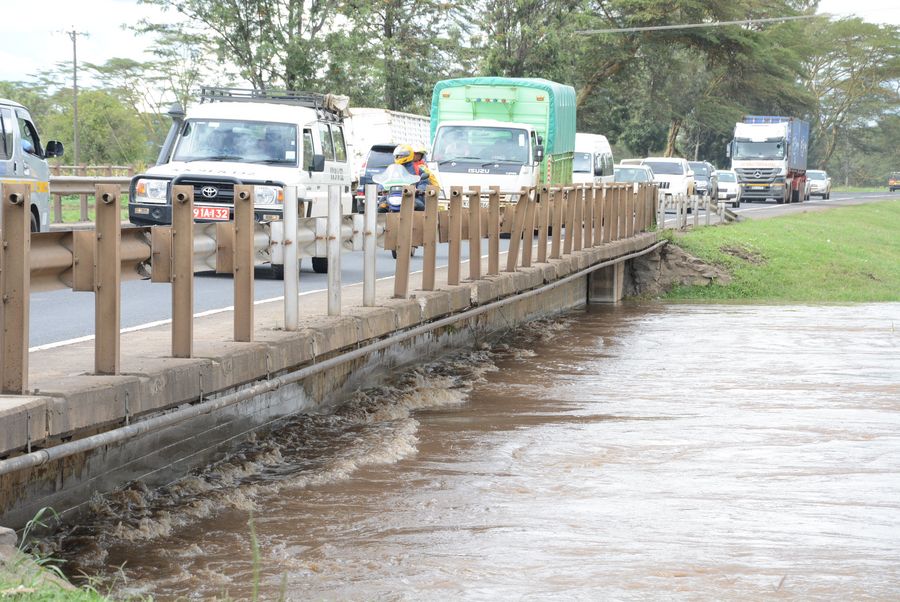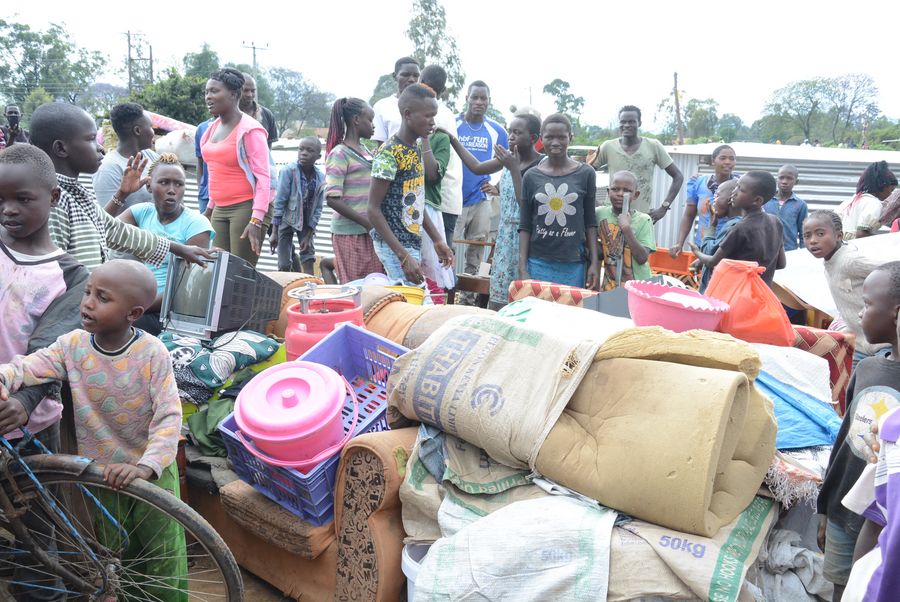
Motorists drive past the flooded River Malewa which bursts its banks following heavy rains in the catchment area of Kinangop in Nyandarua County, in Naivasha, Kenya, Dec. 4, 2019. (Xinhua/Robert Manyara)
The ongoing heavy rains in Kenya have turned drying rivers into a menace, which swept away farmers' crops and vegetables and displaced hundreds of families. At least 132 people have been killed, over 17,000 displaced and 330,000 affected by the rains.
by Bedah Mengo
NAIROBI, Dec. 5 (Xinhua) -- The river water of Athi in Kenya flowed with vengeance, sweeping anything on its path away.
The height of the river Athi on the south of Nairobi, Kenya's capital, has risen to an unprecedented level on Wednesday morning, threatening to carry away a bridge that is 20 meters high.
Standing on the banks of the river watching the furious water were tens of shocked residents, among them tree seedlings growers and vegetable farmers who grow the plants on the banks.
Some of their crops had been swept away by the raging waters which had seen the river expand its depth and breadth.
"We go to the banks of the river to buy vegetables every morning from the farmers. Today we went there and found the farms flooded, and vegetables washed away," said Beatrice Kitula, a vegetable seller in Kitengela.
For many residents, it is the first time they are seeing the river, where people fetch water and water their animals, in such a state.
Few months ago, the river appeared to be on its deathbed thanks to a lengthy dry spell and harmful human activities, among them pollution.
But heavy rains have given it a new lease of life, turning the once drying river into a menace.

Residents transferred to safer places after nearby River Malewa burst its banks following heavy rains currently pounding parts of the catchment area of Kinangop in Nyandarua County, Kenya, Dec. 4, 2019. (Xinhua/Robert Manyara)
The river, which flows through eastern Kenya into the Indian Ocean represents the current state of the water bodies across the east African nation.
Various parts of the east African nation have in the last two weeks been receiving rains of up to 100mm in a day, according to Kenya Meteorological Department (KMD).
The rainwater, which ends up in rivers, has made them burst their banks leading to deaths of several people, displacement of thousands and destruction of property worth thousands of shillings.
In western Kenya, River Nyando in Kisumu County on Tuesday broke its banks displacing over 600 residents.
Residents lamented that they had lost hundreds of their animals and acres of crops, with the floods pushing them to camps.
It is the same case in the neighboring Busia County where River Nzoia has overflown flooding farms.
"Heavy rainfall is expected in Nzoia catchment in Budalangi for the next three days. Residents living next to the river are advised to relocate to higher grounds," KMD issued a caution on Wednesday.
At the Coast, Tana River whose waters in the past months had declined due to dry spell burst its banks and flooded several villages.

Residents shift to safe places by boat following the ongoing floods in Kakola village in Nyando, Kisumu County, Kenya, Dec. 2, 2019. (Xinhua/Fred Mutune)
It is the same case in Garissa, Marsabit and Mandera, arid areas in the North where rains were initially scarce.
And in Makueni, another arid region, River Muoni has displaced hundreds of families as its waters overflew the banks.
Most of the citizens residing in areas where there are rivers are living in fear as the rains continue to pound the east African nation.
For residents in arid areas, the rains have bought more challenges as seasonal rivers that had disappeared years ago are back having found a new lease of life from the rains.
In Kitengela, some residents had their homes flooded on Monday as a seasonal river "woke up".
The Kenya Meteorological Department has warned that the heavy rains would continue in the coming days and the rest of December.
In a statement on Wednesday, the department isolated Nairobi, West Pokot, Siaya and Mukueni, among other 28 regions, as areas that would receive heavy rains.
"The heavy rainfall that is being experienced across the country has led to high flows in most rivers, triggering flooding," said KMD.
At least 132 people have been killed, over 17,000 displaced and 330,000 affected by the rains, government spokesman Cyrus Oguna said on Tuesday. He added that several acres of crops have been destroyed and hundreds of animals swept away.
Kenya needs 200 billion shillings (2 billion U.S. dollars) to deal with the disaster, with the money going to cater for flood victims and reconstruct destroyed infrastructure.



